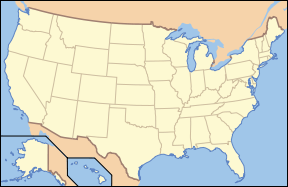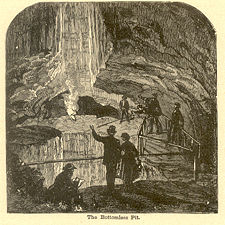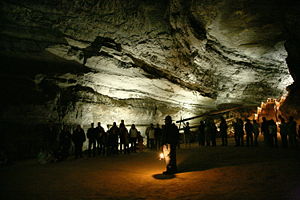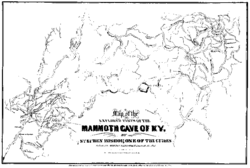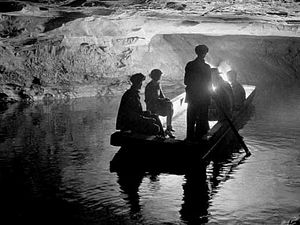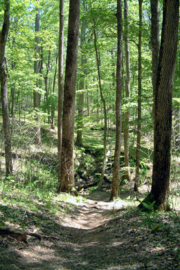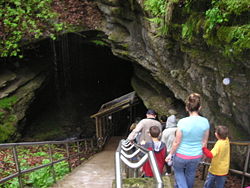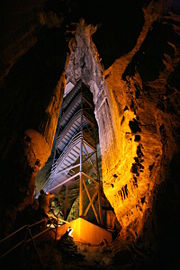Mammoth Cave National Park
2008/9 Schools Wikipedia Selection. Related subjects: North American Geography
| Mammoth Cave National Park | |
|---|---|
| IUCN Category II ( National Park) | |
| Location | Edmonson, Hart, and Barren counties, Kentucky, USA |
| Nearest city | Cave City |
| Coordinates | |
| Area | 52,835 acres (214 km²) |
| Established | July 1, 1941 |
| Visitors | 597,934 (in 2006) |
| Governing body | National Park Service |
| Mammoth Cave National Park* | |
|---|---|
| UNESCO World Heritage Site | |
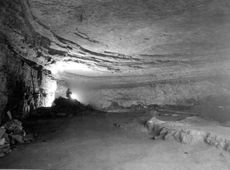 |
|
| Type | Natural |
| Criteria | vii, viii, x |
| Reference | 150 |
| Region† | Europe and North America |
| Inscription history | |
| Inscription | 1981 (5th Session) |
| * Name as inscribed on World Heritage List. † Region as classified by UNESCO. |
|
Mammoth Cave National Park is a U.S. National Park in central Kentucky, encompassing portions of Mammoth Cave, the longest cave system known in the world. The official name of the system is the Mammoth Cave System for the ridge under which the cave has formed. The park was established as a national park on July 1, 1941. It became a World Heritage Site on October 27, 1981, and an international Biosphere Reserve on September 26, 1990.
The park's 52,830 acres (214 km²) are located primarily in Edmonson County, Kentucky, with small areas extending eastward into Hart County and Barren County. It is centered around the Green River, with a tributary, the Nolin River, feeding into the Green just inside the park. The Green River is dammed near the western boundary of the park, so that the river only flows freely for a small section in the eastern part of the park.
Limestone labyrinth
Mammoth Cave developed in thick Mississippian-aged limestone strata capped by a layer of sandstone, making the system remarkably stable. It is known to include more than 367 miles (591 kilometers) of passageway; new discoveries and connections add several miles to this figure each year. Mammoth Cave National Park was established to preserve the cave system.
The upper sandstone member is known as the Big Clifty Sandstone: thin, sparse layers of limestone interspersed within the sandstones give rise to an epikarstic zone, in which tiny conduits (cave passages too small to enter) are dissolved. The epikarstic zone concentrates local flows of runoff into high-elevation springs which emerge at the edges of ridges. The resurgent water from these springs typically flows briefly on the surface before sinking underground again at elevation of the contact between the sandstone caprock and the underlying massive limestones. It is in these underlying massive limestone layers that the human-explorable caves of the region are developed.
The limestone layers of the stratigraphic column beneath the Big Clifty, in increasing order of depth below the ridgetops, are the Girkin Formation, the Ste. Genevieve Limestone, and the St. Louis Limestone. For example, the large Main Cave passage seen on the Historic Tour is located at the bottom of the Girkin and the top of the St. Genevieve.
Each of the primary layers of limestone are divided further into named units and subunits. One area of cave research involves correlating the stratigraphy with the cave survey produced by explorers. This makes it possible to produce three dimensional approximate maps of the contours of the various layer boundaries without the necessity for test wells and extracting core samples.
The upper sandstone caprock is relatively hard for water to penetrate: the exceptions are where vertical cracks occur. This protective role means that many of the older, upper passages of the cave system are very dry, with no stalactites, stalagmites, or other formations which require flowing or dripping water to develop.
However, the sandstone caprock layer has been dissolved and eroded at many locations within the park, such as the Frozen Niagara room. The "contact" between limestone and sandstone can be found by hiking from the valley bottoms to the ridgetops: typically, as one approaches the top of a ridge, the outcrops of exposed rock seen change in composition from limestone to sandstone at a well-defined elevation, neglecting slump blocks of sandstone which have broken off the ridgetops and tumbled down the limestone slopes below.
At one valley bottom in the southern region of the park, a massive sinkhole has developed. Known as "Cedar Sink," the sinkhole features a small river entering one side and disappearing back underground at the other side.
Mammoth Cave is home to the endangered Kentucky cave shrimp, a sightless albino shrimp.
Visiting
The National Park Service offers several cave tours to visitors. Many of the most famous features of the cave, such as Grand Avenue, Frozen Niagara, and Fat Man's Misery, can be seen on lighted tours ranging from one to six hours in length. Two tours, lit only by visitor-carried paraffin lamps, are popular alternatives to the electric-lit routes. Several "wild" tours venture away from the developed parts of the cave into muddy crawls and dusty tunnels.
The park's tours are notable for the quality of the interpretive program, with occasional graphics accompanying artifacts on display at certain points in the cave. The lectures delivered by the National Park Service cave guides are varied by tour, so that in taking several tours the visitor learns about different facets of the cave's formation, or of the cave's human history and prehistory. Most guides are quite knowledgeable and open to visitor's questions. Many guides include a "theatrical" component, making their presentations entertaining with gentle humor. The guide traditions at Mammoth Cave date back to the period just after the War of 1812, and to guides such as Stephen Bishop. The style of this humor itself is part of the living tradition of the cave guides, and is duly a part of the interpretive program.
The Echo River Tour, one of the cave's most famous attractions, used to take visitors on a boat ride along an underground river. The tour was discontinued for logistic and environmental reasons in the early 1990s.
Interested members of the public can join an Earthwatch.org sponsored field survey of the history of Mammoth Cave. However, due to Mammoth Cave park regulations, participation on this project is restricted to US citizens only.
Park superintendents
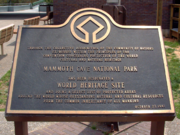
List is incomplete.
- Robert P. Holland; September 2, 1936 – June 21, 1938; acting
- R. Taylor Hoskins; June 22, 1938 – June 30, 1941; acting
- R. Taylor Hoskins; July 1, 1941 – March 31, 1951
- Thomas C. Miller; April 1, 1951 – June 30, 1954
- Perry E. Brown; July 1, 1954 – September 14, 1963
- Paul McG. Miller; September 15, 1963 – December 30, 1965
- John A. Aubuchon; January 2, 1966 – September 7, 1968
- Robert H. Bendt; September 8, 1968 – January 23, 1971; assigned line supervision of Abraham Lincoln Birthplace National Historic Site, September 2, 1970 – April 27, 1975
- Joseph Kulesza; February 21, 1971 – May 31, 1976
- Albert A. Hawkins; July 4, 1976 – August 11, 1979
- Robert L. Deskins; August 12, 1979 – September 1, 1984
- Richard N. Strange; September 2, 1984 – December 8, 1984; acting
- Franklin D. Pridemore; December 9, 1984 – January 2, 1988
- David A. Mihalic; January 3, 1988 – July 1994
- Ronald R. Switzer; March 1995 – January 2005
- Bruce Powell; January 2005 – January 2006; acting
- Patrick Reed; January 2006 –
History
The story of human beings in relation to Mammoth Cave spans six thousand years.
Prehistory
Several sets of Native American remains have been recovered from Mammoth Cave, or other nearby caves in the region, in both the 19th and 20th centuries. Most mummies found present examples of intentional burial, with ample evidence of pre-Columbian funerary practice.
An exception to purposeful burial was discovered when in 1935 the remains of an adult male were discovered under a large boulder. The boulder had shifted and settled onto the victim, a pre-Columbian miner, who had disturbed the rubble supporting it. The remains of the ancient victim were named "Lost John" and exhibited to the public into the 1970s, when they were interred in a secret location in Mammoth Cave for reasons of preservation as well as emerging political sensitivities with respect to the public display of Native American remains.
Research beginning in the late 1950s led by Patty Jo Watson of Washington University in St. Louis, Missouri has done much to illuminate the lives of the late Archaic and early Woodland peoples who explored and exploited caves in the region. Preserved by the constant cave environment, dietary evidence yielded carbon dates enabling Watson and others to determine the age of the specimens, and an analysis of their content, also pioneered by Watson, allows determination of the relative content of plant and meat in the diet of either culture over a period spanning several thousand years. This analysis indicates a timed transition from a hunter-gatherer culture to plant domestication and agriculture.
Another technique employed in archaeological research at Mammoth Cave was "experimental archaeology", in which modern explorers were sent into the cave using the same technology as that employed by the ancient cultures whose leftover implements lie discarded in many parts of the cave. The goal was to gain insight into the problems faced by the ancient people who explored the cave, by placing the researchers in a similar physical situation.
Ancient human remains and artifacts within the caves are protected by various federal and state laws. One of the most basic facts to be determined about a newly discovered artifact is its precise location and situation. Even slightly moving a prehistoric artifact contaminates it from a research perspective. Explorers are properly trained not to disturb archaeological evidence, and some areas of the cave remain out-of-bounds for even seasoned explorers, unless the subject of the trip is archaeological research on that area.
Besides the remains that have been discovered near the historic entrance of Mammoth Cave, the remains of cane torches used by Native Americans were found in Salts Cave in Flint Ridge.
Earliest known history
The 31,000-acre (130 km²) tract known as the "Pollard Survey" was sold by indenture September 10, 1791 in Philadelphia by William Pollard. 19,897 acres (80.52 km²) of the "Pollard Survey" between the North bank of Bacon Creek and the Green River (Kentucky) were purchased by Thomas Lang, Jr., a British American merchant from York County, England on June 3, 1796, for £4,116.13S. The land was lost to a local county tax claim during the War of 1812.
Legend has it that the first European to discover Mammoth Cave was John Houchin, in 1797. While hunting, Houchin pursued a wounded bear to the cave's large entrance opening near the Green River. Countervailing against this story is Brucker and Watson's The Longest Cave, which asserts that the cave was "certainly known before that time."
The land containing this historic entrance was first surveyed and registered in 1798 under the name of Valentine Simons. Simons began exploiting Mammoth Cave for its saltpeter reserves.
19th century
In partnership with Valentine Simon, various other individuals would own the land through the War of 1812, when Mammoth Cave's saltpeter reserves became significant due to the British blockade of United States's ports. The blockade starved the American military of saltpeter and therefore gunpowder. As a result, the domestic price of saltpeter rose and production based on nitrates extracted from caves such as Mammoth Cave became more lucrative.
In July 1812, the cave was purchased from Simon and other owners by Charles Wilkins and an investor from Philadelphia named Hyman Gratz. Soon the cave was being mined for calcium nitrate on an industrial scale.
A half-interest in the cave changed hands for ten thousand dollars (a huge sum at the time). After the war when prices fell, the workings were abandoned and it became a minor tourist attraction centering on a Native American mummy discovered nearby.
When Wilkins died his estate's executors sold his interest in the cave to Gratz. In the spring of 1838, the cave was sold by the Gratz brothers to Franklin Gorin, who intended to operate Mammoth Cave purely as a tourist attraction, the bottom long having since fallen out of the saltpeter market. Gorin was a slave owner, and used his slaves as tour guides. One of these slaves would make a number of important contributions to human knowledge of the cave, and become one of Mammoth Cave's most celebrated historical figures.
Stephen Bishop, an African-American slave and a guide to the cave during the 1840s and 1850s, was one of the first persons to make extensive maps of the cave, and named many of the cave's features.
Stephen Bishop was introduced to Mammoth Cave in 1838 by Franklin Gorin. Gorin wrote, after Bishop's death: "I placed a guide in the cave --- the celebrated and great Stephen, and he aided in making the discoveries. He was the first person who ever crossed the Bottomless Pit, and he, myself and another person whose name I have forgotten were the only persons ever at the bottom of Gorin's Dome to my knowledge.
"After Stephen crossed the Bottomless Pit, we discovered all that part of the cave now known beyond that point. Previous to those discoveries, all interest centered in what is known as the "Old Cave" . . . but now many of the points are but little known, although as Stephen was wont to say, they were 'grand, gloomy and peculiar.'
In 1839, Dr. John Croghan of Louisville bought the Mammoth Cave Estate, including Bishop and its other slaves from their previous owner, Franklin Gorin. Croghan briefly ran an ill-fated tuberculosis hospital in the cave, the vapors of which he believed would cure his patients. A widespread epidemic of the period, tuberculosis would ultimately claim the lives of both Bishop and Croghan.
Throughout the 19th century, the fame of Mammoth Cave would grow so that the cave became an international sensation.
At the same time, the cave attracted the attention of 19th century writers such as Dr. Robert Montgomery Bird, the Rev. Robert Davidson, the Rev. Horace Martin, Alexander Clark Bullitt, Nathaniel Parker Willis (who visited in June 1852), Bayard Taylor (in May, 1855), Dr. William Stump Forwood (in Spring 1867), the naturalist John Muir (early September 1867), the Rev. Horace Carter Hovey, and others. As a result of the growing renown of Mammoth Cave, the cave boasted famous visitors such as actor Edwin Booth, singer Jenny Lind (who visited the cave on April 5, 1851), and violinist Ole Bull.
By 1859 when the Louisville and Nashville Railroad opened its main line between these cities Colonel Larkin J. Procter owned the Mammoth Cave Estate. He also owned the stagecoach line that ran between Glasgow Junction ( Park City) and the Mammoth Cave Estate. This line transported tourists to Mammoth Caves until 1886 when he established the Mammoth Cave Railroad.
Early 20th century: The Kentucky Cave Wars
The difficulties of farming life in the hardscrabble, poor soil of the cave country influenced local owners of smaller nearby caves to see opportunities for commercial exploitation, particularly given the success of Mammoth Cave as a tourist attraction. The "Kentucky Cave Wars" were a period of bitter competition between local cave owners for tourist money. Broad tactics of deception were used to lure visitors away from their intended destination to these private show caves. Misleading signs were placed along the roads leading to the Mammoth Cave. A typical strategy during the early days of automobile travel involved a representative of a private show cave hopping aboard a tourist's car's running board, and leading the passengers to believe that Mammoth Cave was closed, quarantined, caved in or otherwise inaccessible.
In 1906, Mammoth Cave became accessible by steamboat with the construction of a lock and dam at Brownsville, Kentucky. The construction of this dam has had a long-term impact on the biota of the cave. The dam's construction would also prove to have implications for cave exploration.
In 1908, Max Kaemper, a young German mining engineer arrived at the cave by way of New York. Kaemper had just graduated from technical college and his family had sent him on a trip abroad as a graduation present. Originally intending to spend two weeks at Mammoth Cave, Kaemper spent several months. With the assistance of African-American slave descendant Ed Bishop, Kaemper produced a remarkably accurate instrumental survey of many kilometers of Mammoth Cave, including many new discoveries. Reportedly, Kaemper also produced a corresponding survey of the land surface overlying the cave: this information would have been useful in the opening of other entrances to the cave, as soon happened with the Violet City entrance.
The Croghan family suppressed the topographic element of Kaempers map, and it is not known to survive today, although the cave map portion of Kaemper's work stands as a triumph of accurate cave cartography: not until the early 1960s and the advent of the modern exploration period would these passages be surveyed and mapped with greater accuracy. Kaemper returned to Berlin, and from the point of view of the Mammoth Cave country, disappeared entirely. It was not until the turn of the 21st century that a group of German tourists, after visiting the cave, researched Kaemper's family and determined his sad fate: the young Kaemper was killed in trench warfare in World War I at the Battle of the Somme (1916) just eight years later.
Famed French cave explorer Édouard-Alfred Martel visited the cave for three days in October 1912. Without access to the closely held survey data, Martel was permitted to make barometric observations in the cave for the purpose of determining the relative elevation of different locations in the cave. He identified different levels of the cave, and correctly noted that the level of Echo River within the cave was controlled by that of the Green River on the surface. Martel lamented the 1906 construction of the dam at Brownsville, pointing out that this made a full hydrologic study of the cave impossible. Among his precise descriptions of the hydrogeologic setting of Mammoth Cave, Martel offered the speculative conclusion that Mammoth Cave was connected to Salts and Colossal Caves: this would not be proven correct until 60 years after Martel's visit.
In the early 1920s, George Morrison blasted a number of entrances to Mammoth Cave on land not owned by the Croghan Estate. Absent the data from the Croghan's secretive surveys, performed by Kaemper, Bishop, and others, which had not been published in a form suitable for determining the geographic extent of the cave, it was now conclusively shown that the Croghans had been for years exhibiting portions of Mammoth Cave which were not under land they owned. Lawsuits were filed and for a time, different entrances to the cave were operated in direct competition with each other.
In the early 20th century, Floyd Collins spent ten years exploring the Flint Ridge Cave System (the most important legacy of these explorations was the discovery of Floyd Collins' Crystal Cave and exploration in Salts cave) before dying at Sand Cave, Kentucky, in 1925. While exploring Sand Cave, he dislodged a rock onto his leg while in a tight crawlway and was unable to free himself. Attempts to rescue Collins created a media sensation.
The National Park Movement (1926–1941)
As the last of the Croghan heirs died, advocacy momentum grew among wealthy citizens of Kentucky for the establishment of Mammoth Cave National Park. Private citizens formed the Mammoth Cave National Park Association in 1926. The Park was authorized May 25, 1926.
Donated funds were used to purchase some farmsteads in the region, while other tracts within the proposed National Park boundary were acquired by right of eminent domain. In contrast to the formation of other National Parks in the sparsely populated American West, thousands of people would be forcibly relocated in the process of forming Mammoth Cave National Park. Often eminent domain proceedings were bitter, with landowners paid what was considered to be inadequate sums. The resulting acrimony still resonates within the region.
For legal reasons, the federal government was prohibited from restoring or developing the cleared farmsteads while the private Association held the land: this regulation was evaded by the operation of "a maximum of four" CCC camps from May 22, 1933 to July 1942.
According to the National Park Service, "On May 14, 1934 the minimum park area was provided. On May 22, 1936, the minimum area was accepted for administration and protection."
Superintendent Hoskins later wrote of a summer tanager named Pete who arrived at the guide house on or around every April 20, starting in 1938. The bird ate from food held in the hands of the guides, to the delight of visitors, and provided food to his less-tame mate.
Birth of the National Park (1941)
Mammoth Cave National Park was officially dedicated on July 1, 1941. By coincidence, the same year saw the incorporation of the National Speleological Society. R. Taylor Hoskins, the second Acting Superintendent under the old Association, became the first official Superintendent, a position he held until 1951.
The New Entrance, closed to visitors since 1941, was reopened on December 26, 1951, becoming the entrance used for the beginning of the Frozen Niagara tour.
"The Longest Cave" (1954–1972)
By 1954, Mammoth Cave National Park's land holdings encompassed all lands within its outer boundary with the exception of two privately held tracts. One of these, the old Lee Collins farm, had been sold to Harry Thomas of Horse Cave Kentucky, whose grandson, William "Bill" Austin, operated Collins Crystal Cave as a show cave in direct competition with the National Park, which was forced to maintain roads leading to the property. Condemnation and purchase of the Crystal Cave property seemed only a matter of time.
In February 1954, a two-week expedition under the auspices of the National Speleological Society was organized at the invitation of Austin: this expedition became known as C-3, or the "Collins Crystal Cave" expedition.
The C-3 expedition drew public interest, first from a photo essay published by Robert Halmi (in either Sports Illustrated or Look magazine) and later from the publication of a double first-person account of the expedition, The Caves Beyond: The Story of the Collins Crystal Cave Expedition by Joe Lawrence, Jr. (then president of the National Speleological Society) and Roger W. Brucker. The expedition proved conclusively that passages in Crystal Cave extended toward Mammoth Cave proper, at least exceeding the Crystal Cave property boundaries. However, this information was closely held by the explorers: it was feared that the National Park Service might forbid exploration were this known.
In 1955 Crystal cave was connected with Unknown cave, the first connection in the Flint Ridge system.
Some of the participants in the C3 expedition wished to continue their explorations past the conclusion of the C-3 Expedition, and organized as the Flint Ridge Reconnaissance under the guidance of Austin, Jim Dyer, John J. Lehrberger and E. Robert Pohl. This organization was incorporated in 1957 as the Cave Research Foundation, Inc. The organization sought to legitimize the cave explorers' activity through the support of original academic and scientific research. Notable scientists who studied Mammoth Cave during this period include Patty Jo Watson (see section on prehistory.)
Colossal Cave was connected to Salts Cave in 1960 and in 1961 all the cave entrances in the Flint Ridge system were connected.
In March 1961, the Crystal Cave property was eventually sold to the National Park Service for a sum of USD $285,000. At the same time, the Great Onyx Cave property, the only other remaining private inholding, was purchased for USD $365,000. The Cave Research Foundation was permitted to continue their exploration through a Memorandum of Understanding with the National Park Service.
Flint–Mammoth Connection (1972)
On September 9, 1972, a Cave Research Foundation mapping team led by John P. Wilcox, Patricia Crowther, Richard B. Zopf, P. Gary Eller, Stephen G. Wells, and Cleveland F. Pinnix (a National Park Service Ranger) managed to pursue a low, wet passage that linked two of the area's long cave systems—Flint Ridge Cave System to Mammoth Cave. This connection made the combined Flint–Mammoth Cave System the world's longest. (Flint Ridge had itself recently surpassed Hölloch Cave, in Switzerland, as the world's longest cave.)
On a previous trip deep in the Flint Ridge Cave System, Patricia Crowther—with her slight frame of 115 pounds (52 kilograms)—crawled through a narrow canyon later dubbed the "Tight Spot", which acted as a filter for larger cavers.
A subsequent trip fielded past the Tight Spot by Crowther, Wilcox, Zopf, and Tom Brucker found the name "Pete H" inscribed on the wall with an arrow pointing in the direction of Mammoth Cave. The name is believed to have been carved by Pete Hanson, who was active in exploring the cave in the 1930s. Hanson was killed in World War II. The passage was named Hanson's Lost River.
On the September 9 trip, following Hanson's Lost River led the six-person team to Cascade Hall in Mammoth Cave, final proof that the caves were connected. John Wilcox emerged in waist deep water to see a regular horizontal line across his field of vision, which proved to be a tourist handrail: the "One small step for a man" quote for "conquering the Everest of speleology" was his exclamation to the others "I see a tourist trail!" Of all of the many miles of Mammoth Cave, only a small fraction is developed with trails and lighting, so it was remarkable that the moment of connection took place in an utterly familiar setting.
Recent discoveries
Further connections between Mammoth Cave and smaller caves or cave systems have followed, notably to Proctor/Morrison Cave beneath nearby Joppa Ridge in 1979. Proctor cave was discovered by Jonathan Doyle, a Union army deserter during the Civil war and was later owned by the Mammoth cave railroad, before being explored by the CRF. Morrison cave was discovered by George Morrison in the 1920s. This connection pushed the frontier of Mammoth exploration southeastward.
At the same time, discoveries made outside the Park by an independent group called the Central Kentucky Karst Coalition or CKKC resulted in the survey of tens of miles in Roppel Cave east of the Park. On September 10, 1983, a connection was made between the Proctor/Morrison's section of the Mammoth Cave system and Roppel Cave. The connection was made by two mixed parties of CRF and CKKC explorers. Each party entered through a separate entrance and met in the middle before continuing in the same direction to exit at the opposite entrance. The resulting total surveyed length was near 300 miles (480 km). Incremental discoveries since then have pushed the total to more than 367 miles (591 km).
In early 2005, a connection into the Roppel Cave portion of the system was surveyed from a small cave under Eudora Ridge.
It is accepted with certainty that many more miles of cave passages await discovery in the region.
Related and nearby caves
Two other massive cave systems lie short distances from Mammoth Cave: the Fisher Ridge Cave System and the Martin Ridge Cave System. The Fisher Ridge Cave System was discovered in January 1981 by a group of Michigan cavers . So far, the cave has been mapped to 110 miles / 177 kilometers (Gulden, B. 2007). In 1996, the Martin Ridge Cave was discovered by John Alan Glennon and Jonathan David Jasper. Connections discovered by Glennon and Jasper to nearby Whigpistle and Jackpot Caves resulted in the 32 mile / 51 kilometer-long Martin Ridge Cave System.
If connections are found between the three giant caves—Fisher Ridge Cave System, Martin Ridge Cave System and Mammoth Cave—the total mapped system would exceed 500 miles / 800 kilometers (Gulden, B. 2005).
Biology and ecosystem
The bats that inhabit the caverns are the following: Indiana bats ( Myotis sodalis), Gray bats ( Myotis grisescens), Little brown bats ( Myotis lucifugus), Big brown bat ( Eptisecus fuscus), and the Eastern pipistrelle bat ( Pipistrellus subflavus)
All together, these and more rare bat species such as eastern small-footed bat had estimated populations of 9-12 million just in the Historic Section. While these species still exist in Mammoth Cave, their numbers are now no more than a few thousand at best. Ecological restoration of this portion of Mammoth Cave, and facilitating the return of bats, is an ongoing effort. Not all bat species here inhabit the Cave; the red bat (Lasiurus borealis) is a forest-dweller, found underground only rarely.
Other animals which inhabit the caves, include: Cave Cricket ( Hadenoecus subterraneous), Blind Salamander, Cave salamander, Eyeless Cave Fish, Cave Crayfish ( Orconectes pellucidus), and the Cave Shrimp ( Palaemonias ganteri)
In addition, some surface animals may take refuge in the entrances of the caves but do not generally venture into the deep portions of the cavern system.
Common misconceptions
Misconceptions relating to Mammoth Cave's impressive length
The superlatives which are justly applied to Mammoth Cave often lead to exaggeration of the cave's extent and reach. One such misconception is that the cave extends far beyond its well-known geographical boundaries, even to other states in the United States. This misconception is easily debunked. Caves of Mammoth's type form as water from the surface seeks the level of the surface streams which drain them: in Mammoth Cave's case, the Green River to the north. It is a virtual certainty that no cave passages connecting to Mammoth will ever be found north of the Green River, or substantially east of the Sinkhole Plain which is the primary recharge area (the place where water enters) for the cave. More tantalizing is the prospect of ancient passages to the south which might bridge the current drainage divide between the Green River basin and the Barren River basin south of it, but in that case, the maximum expected southerly extent of Mammoth Cave would be the Barren River.
It is true, however, that the layers of sedimentary rock in which Mammoth Cave has formed do extend many miles in almost any direction from Mammoth Cave. These rocks were all laid down over the same period. The similarity of the rocks of the broader region to those in the immediate vicinity of Mammoth Cave means that conditions are right for cave formation; however, the absolute boundaries of the Mammoth Cave system are known, so it is expected that these other caves will not be found to connect to Mammoth Cave.
Misconceptions related to the Mammoth Cave System's name
No fossils of the woolly mammoth have ever been found in Mammoth Cave, and the name of the cave has nothing to do with this extinct mammal. Rather, the appellation "Mammoth" refers to the staggering primacy of its horizontal extent to that of other caves. An historical irony results in that although the name was applied before the cave system's true extent was fully known, modern discoveries have well established the appropriateness of the older name. Indeed, an enduring characteristic of the story of the cave's exploration is how often old predictions of the cave's final length have been far outstripped by actual discoveries. In spite of the above description of the absolute geographical confines of the cave system's reach, it is accepted by most informed researchers that many more miles of the Mammoth Cave system await discovery. The extra mileage to be discovered will likely occur both in the form of new passages that await discovery (as more sophisticated techniques of cave exploration develop) and of neighboring cave systems whose extensive mileage could, at any moment, be found to be part of Mammoth Cave through the discovery of passages linking these heretofore-considered independent caves.
